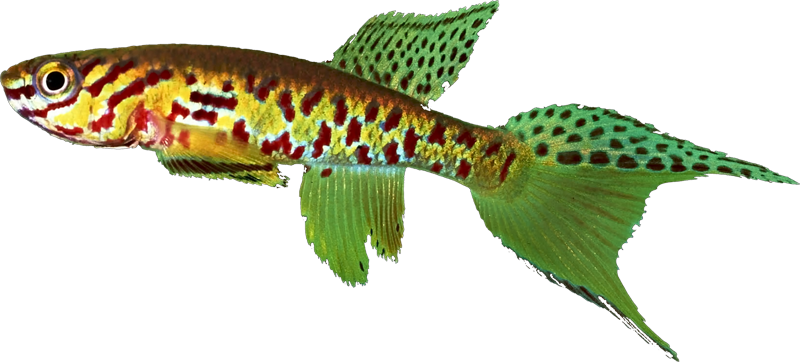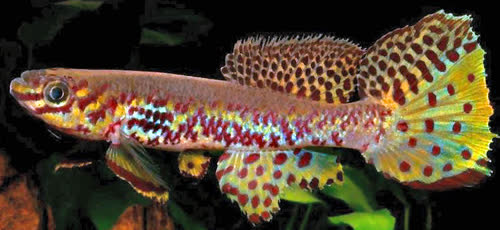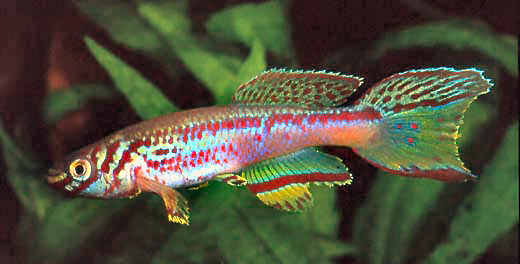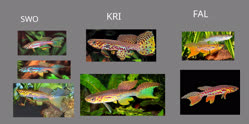FAL is a species from a restricted range in lower Guinea Fores west of the Dahomey gap but the type specimen is purported to be "Ghana". Whether it is a cameroon fish that comports to FAL as we know it and a simple error soemwhere got ther wrong name on it or it's a fallax tyope fish actually from Ghana, which is unliely. Eschemeyer points out of all ichtyologists, AHlm made the most mistakes, so it does not seem that improbable. Physical examinations of the hypes so far have not proved fruitful althought to my knoldege a details study of the skeletel remains has not so far been undertaken.
FAL is poorly defined in the literature, but well known in the hobby mostly because of the aquarium hobby - shipments of imported FAL are not terribly uncommon and hobbyist colectois have also introduced them into the hobby. Large fundulopanchas other than SJO have eben imported throughiouyt the 20th century . "Yellow gularis" seemed to be a popular monniker; in killi corcles it seems to alweays bee around here ans there are more of the morte populat lare FPX, which is a tough sell as killies tend to be housed in small tanks but these and half sa dozen others are
large their size means less space for everything. Yet they persis as a perennial favorite.
Ahl discovered this fish, preserved a specimen and labeled it as being from Ghana in his notebook, which sems impossible as the arers is well explored and only WAL and SPU are there, not other Fundulopanchax or Aphyosemion, s there are replaced i ngemneral, by Callopanchini (Callopancxhas, Scriptaphyosemion ans allied genera). Fish in the FAL species group are found in Cameroon,

thousands of miles away. Worse, the type specimen in the British Museum is hoplessly mangled and nothing can be learned from it according to Huber (pers comms). New types are required or the name is really Nomen Nudum and not a valid name. New type specimens from the original would establish FAL as a valid name, butr these fish are never and perhaps were never found there. If not we have to find a new name for the fish
from Mouanka. Aphyosemion, "Rolofia" and Fundulopanchax are well studies in the two regions of Ghana and Cameroon, which are about 1000 miles apart. FAL species are found in a fairly restricted range and never west of the Dahomey gap where Ghana is. KIlifauna on both sides of the Fahomey gap are quite different having been isolated for a long time because of the geography of the Dahomey Gap. In contemporary usage "Dahomey Gap" refers to a deforested are in Togo, Benin and Ghana. To the east is the lower guinian forest of Cameroon and Nigeria and to the west it the upper guinean forest: Siera Leoone, Cote d'Ivoire, Liberia and Guinea.
From Alchetron:
"In West Africa, the Dahomey Gap refers to the portion of the Guinean forest-savanna mosaic that extends all the way to the coast in Benin, Togo and Ghana, thus separating the forest zone that covers much of the south of the region into two separate parts. The forest region west of the gap is called the Upper Guinean forests or Guinean forest zone, and the portion east of the gap is called the Lower Guinean forests, Lower Guinean-Congolian forests, or Congolian Forest Zone."
East of the gap,
F. Spurelli and
F. walkeri can be found, but no other Fundulopanchax species let alone the same one as is found in Cameroon.
After decades it appears the fish from Mounka is what we think FAL reprersents; in the 1980s two new and signifiicantly different forms appeared, one from Kribi and one from Malende, described as
F. kribianus and
F. swoiseri respectively.
FAL, SWO and KRI all have a row of heavy carmine spots in the dorsal fin, quite close to, but never touching, the body. Recall that SHO has a unique character in the form of a carmine band ar the base of the dorsal fin.
Thee FAL group do not have this but do have what may perhaps be the remnants of one. If you look at enough killifish for long enough and become famjiliar with the carmine spots and bars and especially the vermiform markingsa og the throat, things become a bit more clear. DEL and FAL group species can by difficult to distinguish from a glance, but up close it's obvious FAL species have carmins vermiform marking on the throat to the underside of the jaw whereas in DEL the marking only go down halfway and the underside of the jaw is white to light beighr and never any markings there. These pattersn very rarely if ever change within a species or species group; in members of tghe FAL complex these vermiform mareking on the throat seem to be consistant and perhaps a reliable way to differentiate members of the GUL group.




 thousands of miles away. Worse, the type specimen in the British Museum is hoplessly mangled and nothing can be learned from it according to Huber (pers comms). New types are required or the name is really Nomen Nudum and not a valid name. New type specimens from the original would establish FAL as a valid name, butr these fish are never and perhaps were never found there. If not we have to find a new name for the fish
from Mouanka. Aphyosemion, "Rolofia" and Fundulopanchax are well studies in the two regions of Ghana and Cameroon, which are about 1000 miles apart. FAL species are found in a fairly restricted range and never west of the Dahomey gap where Ghana is. KIlifauna on both sides of the Fahomey gap are quite different having been isolated for a long time because of the geography of the Dahomey Gap. In contemporary usage "Dahomey Gap" refers to a deforested are in Togo, Benin and Ghana. To the east is the lower guinian forest of Cameroon and Nigeria and to the west it the upper guinean forest: Siera Leoone, Cote d'Ivoire, Liberia and Guinea.
thousands of miles away. Worse, the type specimen in the British Museum is hoplessly mangled and nothing can be learned from it according to Huber (pers comms). New types are required or the name is really Nomen Nudum and not a valid name. New type specimens from the original would establish FAL as a valid name, butr these fish are never and perhaps were never found there. If not we have to find a new name for the fish
from Mouanka. Aphyosemion, "Rolofia" and Fundulopanchax are well studies in the two regions of Ghana and Cameroon, which are about 1000 miles apart. FAL species are found in a fairly restricted range and never west of the Dahomey gap where Ghana is. KIlifauna on both sides of the Fahomey gap are quite different having been isolated for a long time because of the geography of the Dahomey Gap. In contemporary usage "Dahomey Gap" refers to a deforested are in Togo, Benin and Ghana. To the east is the lower guinian forest of Cameroon and Nigeria and to the west it the upper guinean forest: Siera Leoone, Cote d'Ivoire, Liberia and Guinea.